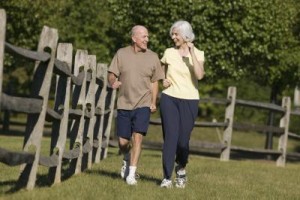Physical exercise and Parkinson’s disease
You may be aware of just how important it is to keep your body active if you have been diagnosed with Parkinson’s disease.
It will help you keep strong, and ensure that your keep more of your ability to move than if you halted movement completely. Of course each case of Parkinson’s disease is different, and what type of movement and exercise program which would suit you is something which you should discuss with your doctor or your movement therapist.
The exercises that you engage with should be suited to your specific needs, both in type of exercises and intensity.
The duration of exercise should also be suited to your physical fitness level as well as the limitations which the symptoms of the illness may present you with. Your overall health is of course a major factor in what type of exercises may be suiting for you as well, but as a general thighs which include soft stretching and resistance training is good such as swimming, water aerobics and yoga.
For Parkinson’s patients often it’s suggested that some facial muscle practice is included, making faces to the mirror, and practicing speaking with over articulation to ensure that deterioration in control of facial movements is slowed, and the risk of being afflicted by the mask face syndrome is lessened.
Exercise is always encouraged, and if you have difficulty in getting up and down, sitting exercises, or exercises in bed is also suggested.
Ensuring that there is a fun part in exercising and learning something new, or a social aspect is also important, perhaps testing out dance therapy or picking up a new hobby such as gardening or tai chi. Speaking to your doctor is highly recommended before starting a new exercise regime.
A Beneficial Approach for Parkinson’s Disease
Living with Parkinson’s disease can be challenging, but emerging research suggests that incorporating physical exercise and certain activities, like drain unblocking, can have profound benefits for patients. In this article, we’ll delve into the connection between physical exercise, drain unblocking, and Parkinson’s disease management.
Understanding Parkinson’s Disease
Parkinson’s disease is a progressive neurological disorder that affects movement control due to a decrease in dopamine production. While medications are commonly used to manage symptoms, there’s growing evidence supporting the role of physical exercise in enhancing overall well-being for Parkinson’s patients.
The Importance of Physical Exercise
Regular physical exercise offers a wide range of benefits, from improving cardiovascular health to boosting mood. In the context of Parkinson’s disease, exercise can help maintain muscle strength, flexibility, and balance, thereby reducing the risk of falls.
Drain Unblocking and its Surprising Impact
Engaging in activities like drain unblocking may seem unrelated, but they can have unexpected benefits. The physical motions involved in such tasks can contribute to increased motor skills and hand-eye coordination in Parkinson’s patients.
How Exercise Affects Brain Health
Exercise triggers the release of neurochemicals that promote brain health. It encourages the growth of new neurons and strengthens neural connections, potentially slowing down the progression of Parkinson’s disease and enhancing cognitive function.
Targeted Exercises for Parkinson’s Patients
Certain exercises are particularly beneficial for Parkinson’s patients. Yoga, Tai Chi, and swimming, for example, can improve muscle tone, flexibility, and balance, while also providing relaxation and stress reduction benefits.
Hydration and Nutritional Considerations
Proper hydration and a balanced diet are crucial for anyone, but especially for those with Parkinson’s. Staying hydrated and consuming nutrient-dense foods can support overall health and energy levels.
Incorporating Drain Unblocking as a Therapeutic Activity
Engaging in everyday activities like drain unblocking can be therapeutic. The focused movements required can enhance fine motor skills and hand dexterity, contributing to improved quality of life.
The Role of Dopamine and Physical Activity
Dopamine, a neurotransmitter, plays a significant role in Parkinson’s disease. Exercise increases dopamine production, potentially helping to alleviate some symptoms and improve mood.
Mind-Body Connection: Stress Reduction and Exercise
Stress can exacerbate Parkinson’s symptoms. Exercise, including activities like drain unblocking, can reduce stress and anxiety, leading to better symptom management.
Building an Exercise Routine: Tips and Strategies
Starting an exercise routine can be daunting, but it’s essential to begin slowly and set achievable goals. Working with a physical therapist or a fitness professional experienced with Parkinson’s patients can provide guidance.
Social Interaction and Support Groups
Exercise classes or support groups tailored for Parkinson’s patients offer a dual benefit. They provide a sense of community and social interaction, along with the advantages of physical activity.
Personalized Approaches to Exercise and Drain Unblocking
Every individual with Parkinson’s is unique. It’s crucial to tailor exercise and activity choices to personal preferences, abilities, and limitations.
Overcoming Challenges and Setting Realistic Goals
Parkinson’s patients may face obstacles, but a positive attitude and realistic goal-setting can lead to steady progress. Celebrating small achievements along the way can provide motivation.
Monitoring Progress and Celebrating Achievements
Regularly tracking exercise routines and drain unblocking activities allows patients to monitor their progress. Celebrating milestones can boost self-esteem and encourage continued efforts.
Empowerment through Exercise and Drain Unblocking
Incorporating physical exercise and activities like drain unblocking into the lives of Parkinson’s patients can bring about multifaceted improvements. From enhanced motor skills and cognitive function to reduced stress and a sense of accomplishment, these approaches empower individuals to take an active role in managing their condition.
FAQs
- Can drain unblocking really make a difference for Parkinson’s patients? Engaging in drain unblocking and similar tasks can contribute to improved motor skills and hand-eye coordination, benefiting Parkinson’s patients.
- Is there a specific exercise routine that Parkinson’s patients should follow? Exercise routines should be tailored to individual preferences and capabilities, with guidance from a healthcare professional.
- How does exercise help with dopamine production? Exercise stimulates the release of dopamine, a neurotransmitter that plays a crucial role in Parkinson’s disease.
- Are there social benefits to participating in exercise classes for Parkinson’s patients? Yes, exercise classes offer not only physical advantages but also a sense of community and support.
